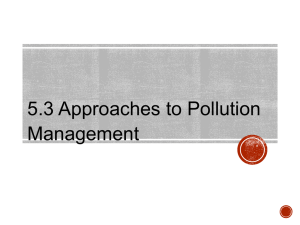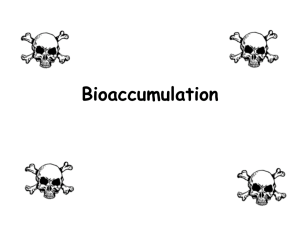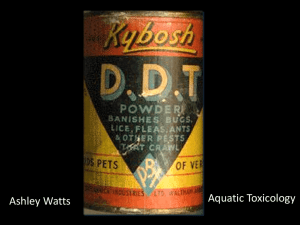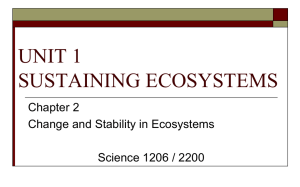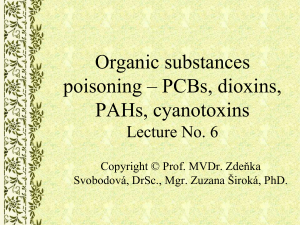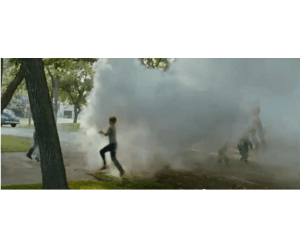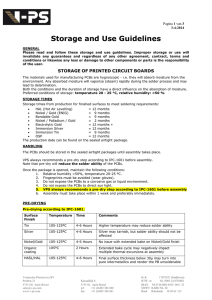Persistent Organic Pollutants
advertisement
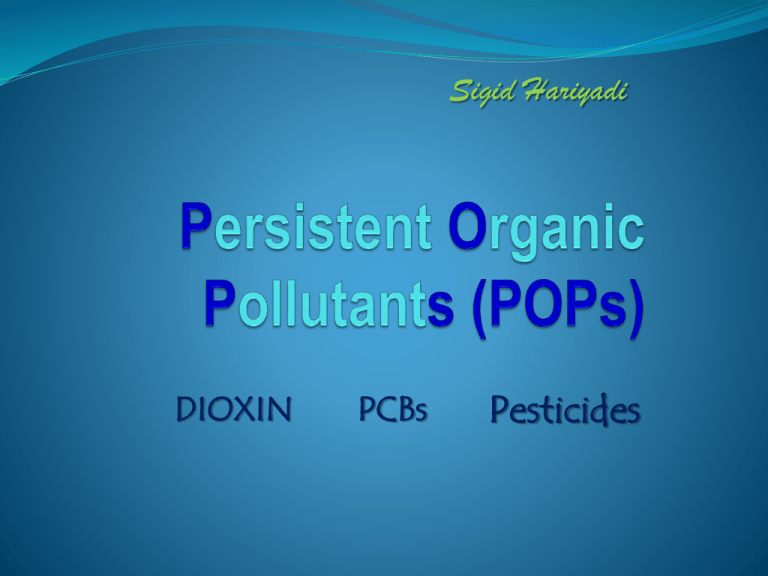
Sigid Hariyadi DIOXIN PCBs Pesticides POPs Persistent Organic Pollutants (POPs) are chemical substances that persist in the environment, bioaccumulate through the food web, and pose a risk of causing adverse effects to human health and the environment. Bahan kimia yang tetap ada di lingkungan (tidak luruh, tidak terurai) Bioakumulasi dalam jejaring makanan Menyebabkan resiko yg merusak bagi kesehatan manusia dan lingkungan The "dirty dozen" includes: (6) endrin (7) heptachlor (1) PCBs (8) hexachlorbenzene (9) mirex (2) aldrin (3) chlordane (10) polychlorinated dibenzo-p-dioxins (11) polychlorinated dibenzofurans, and (4) DDT (12) toxaphene. (5) dieldrin POPs (Persistent Organic Pollutants) Examples = Dioxin, PCB, DDT (Chlorinated) Dioxin: stable; slow to degrade Persistent Organic Pollutants - Dioxin Generated from: burning wood, coal, oil, household trash, and chlorine bleaching of pulp and paper Accumulates in fat of animals biomagnification Causes: - cancer - weakened immune response Persistent Organic Pollutants - PCBs PCBs : non-flammable; not dissolved in water; high boiling points; does not conduct electricity well used for transformers and capacitors. Sources of PCBs Due to their stability, use in industrial processes and product (e.g. dielectric fluida in capasitor and transformator). Production and uses of PCBs Compound Trade Names Major Uses Polychlorinated biphenyls (PCBs) Aroclor; Phemoclor; Kanechlor; Clopen Clophen; Fenclor; Santotherm Capacitor Dielectric; Transformer collant; Hydraulic fluid; Heat transfer fluid. Polychlorinated triphenyls (PCT) Aroclor; Kanechlor Adhesives and sealants Polychlorinated naphthalenes (PCN) Halowax Capasitor dielectric, oil additive Polybrominated biphenyls (PBB) Firemaster Fire retardant Persistent Organic Pollutants - PCBs More than one billion pounds of PCBs have been made Accumulates in fat of animals biomagnification Causes: - cancer - hormonal and reproductive disruptions - decrease cognitive abilities (dopamine) Chemical Structures of PCBs Chemical Properties of PCBs Chemical characteristics of PCBs are mostly determined by positions and number of chlor content High Stability especially those with more than 5 atomic chlor content; (hydro= air, phobia= takut) Hydrophobic; (lipo ⇨ lipid= lemak, philic= suka) Lipophilic; Low solubility. Behaviour of PCBs in an Ecosystem Dispersion (as a function of solubility); Low Degradation (higher chlor content, more difficult to degrade); Mobility and absorption in sediment (higher chlor content, lower mobility); Availability in sediment depend on its texture and organic material content (High PCBs content in fine sediment). Biodegradation of PCBs: Accumulation of PCBs Readily accumulated through water and food PCBs is accumulated in lipid. Sedimentary Organisms are contaminated with a concentration similar or more than that observed in sediment. Elimination of PCBs Elimination of PCBs from organisms is related to the chemical properties cleanse Uptake rate and depuration in mussels is high for higher chlor PCBs, but low for those having low chlor content. Decreasing consentration of PCBs in female organism occurs in a gametogenesis period in which PCBs is transferred to her eggs (more lipophilic), or in a spawning period. PESTISIDA WHAT IS A PESTICIDE ? a pesticide is any agent used to kill or control any pest. Pests can be insects, rodents or birds, unwanted plants (weeds), fungi, or microorganisms such as bacteria and viruses. herbicides fungicides microbiocides rodenticides Many household products are pesticides: • Obat nyamuk dan serangga (semprot, bakar, gel) • racun tikus • bahan anti jamur • berbagai desinfektan (pembersih lantai) http://www.pesticideinfo.org/Docs/ref_general1.html Active ingredients are the specific chemicals contained in a pesticide product that are designed to kill a particular pest. By law, the active ingredient must be identified by name on the label together with its percentage by weight. "Inert" ingredients are commonly mixed with the active ingredients to create a formulated pesticide product. Formulated pesticide products are the form of the pesticide that is available to the consumer, grower, or pest control applicator, and may take the form of sprays, bait stations, fly strips (pita perangkap lalat), dusts, etc. Inert ingredients include solvents, emulsifiers, spreaders, and other substances mixed into pesticide products to increase the effectiveness of the active ingredients, make the product easier to apply, or to allow several active ingredients to mix in one solution. An inert ingredient is simply any ingredient in the product that is not intended to affect a target pest . Inert ingredients can be as much as 99% of pesticide products. Many inert ingredients have adverse health effects and may themselves be used as pesticides. The U.S. EPA list of pesticide inert ingredients: 8 of 382 inert ingr. of toxicological concern 75 of 382 inert ingr. potentially toxic Chemical Structures of Pesticides: Pesticides in Marine Environment Chlorophenoxy acids (e.g. 2,4 D) Substituted tetrahydrophthalinides (e.g. captan) Organochlorine (e.g. p,p’-DDT, lindane, dieldrine, dan mirex) Organophosphorus compounds (e.g. malathion) Carbamate (e.g. carbanyl) Most Common Pesticides DDT = (1,1,1-trichloro-2,2-di(4-chlorophenyl) -ethane), DDD = (1,1-dichloro-2,2-di(4-chlorophenyl)-ethane) DDE = (1,1-dichloro-2,2-di(4-chlorophenyl) -ethylene) Persistent Organic Pollutants - DDT DDT is an insecticide; stable and slow to degrade. Paul Muller won the Nobel Prize in 1948 for developing DDT. Benefits = Controlled spread of malaria; Provided crop protection Persistent Organic Pollutants - DDT Problems with DDT: DDT is not metabolized very rapidly by animals; instead, it is deposited and stored in the fatty tissues biomagnification Persistent Organic Pollutants - DDT Toxic to fish Increased mortality in birds: calcium decreased in egg shells Accumulation of DDT In fish, come through predation, and also skin and gill. Short exposure at a concentration of < 1 µg/L is toxic for freshwater and marine fish. Mature Organisms contaminated DDT can be transferred to embryo and lead to death within a concentration range of 1,1 - 2,4 µg/kg. DDT as Persistent compound due to: Low vapour pressure High solubility in lipid Resistant to degradation and photooxidation Transformation of DDT DDE exists within aerobic or oxidation condition. DDD exists within anaerob or reduction conditions. DDE and DDD have similar stability and toxicity to DDT . Persistent Organic Pollutants - DDT Estrogen mimic in Vertebrates: feminizes males - lower sperm count; alters behavior Human Health: decreased mental function male infertility cancer Persistent Organic Pollutants - Unintentional Pathways: DDT Persistent Organic Pollutants DDT Problems with DDT (and other pesticides): Evolution of resistance Non-target species and creation of new pests Biomagnification of DDT (ppm) Fish-eating birds (0.17 – 2.07) Fish (0.17 – 2.07) shrimp Mud snail Clam Insects 0.16 0.26 0.42 0.23 – 0.3 Organic debris Cladophore Plankton Marsh plants 0.3 – 13.0 0.03 0.04 0.33 – 2.8 Sea-water Fresh-water 1 x 10-6 1 x 10-5 (Preston, 1989) Pesticides Cycles Pesticide Concentration Standard Compound Fresh water aquatic life Human fish consumption Aldrin 3.0 ug/liter (acute) 0.079 ng/liter Chlordane 2.4 ug/liter (acute) 0.46 ng/liter Dieldrin 2.5 ug/liter (acute) 0.076 ng/liter DDT 1.1 ug/liter (acute) 0.024 ng/liter DDE 1,050 ug/liter (acute) N/A Mirex 0.001 ug/liter (chronic) N/A Parathion 0.065 ug/liter (acute) N/A

